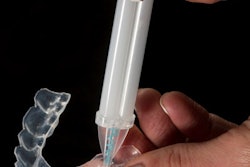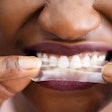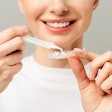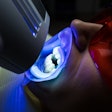
Teeth whitening is one of the most popular cosmetic procedures today, but it can have negative side effects. For example, some studies have reported that whitening agents containing carbamide peroxide or peroxide may soften dental hard tissues.
But a new study has found that adding a remineralizing agent such as casein phosphopeptide-amorphous calcium phosphate (CPP-ACP) to the bleaching agent could mitigate this effect (Operative Dentistry, August 5, 2011).
"I decided to conduct this research since there is still a debate over whether carbamide peroxide- or peroxide-containing agents can soften dental hard tissues," said lead study author Boniek Castillo Dutra Borges, DDS, an assistant professor at the school of dentistry at Potiguar University, in a DrBicuspid.com interview. "We were surprised to find that the use of a CPP-ACP paste (MI Paste, GC America) with carbamide peroxide bleaching agents increased the bleached enamel's microhardness and did not have an influence on whitening efficacy."
“CPP-ACP-containing paste with carbamide peroxides could protect enamel against the demineralization. ...”
— Boniek Borges, DDS
Although a large body of scientific evidence demonstrates that CPP-ACP could promote the remineralization of even enamel subsurface caries lesions, this study is the first to analyze the effect of MI Paste in conjunction with carbamide peroxides on bleached enamel microhardness, the study authors noted.
To evaluate the efficacy of an at-home bleaching technique using 10% or 16% carbamide peroxide modified by CPP-ACP and its influence on the microhardness of bleached enamel, the researchers studied 40 bovine incisors that were stained using a mixture of red wine and tea.
The samples were divided into four groups of 10 each and stored in artificial saliva for a 14-day bleaching regimen. The four groups were bleached using the following:
- 10% carbamide peroxide only
- A blend of 10% carbamide peroxide and a CPP-ACP paste
- 16% carbamide peroxide only
- A blend of 16% carbamide peroxide and a CPP-ACP paste
For two of the 10% and 16% peroxide groups, the peroxides were mixed with MI Paste by combining 1 mL of the bleaching gels with 1 mL of MI Paste until a homogeneous paste was obtained, which was then inserted into a 5-mL syringe. In addition, the peroxides alone were put into 5-mL syringes.
The researchers assessed the microhardness and color of the teeth at baseline and immediately after the 14-day bleaching regimen using a microhardness tester and a spectrophotometer. The degree of color change was determined by the Commission Internationale de l'Eclariage (CIE) L*a*b* system and Vita shade guide parameters.
Among the study's findings:
- The teeth that were bleached with a blend of peroxide (10% or 16%) and the CPP-ACP paste presented increased microhardness values after the bleaching regimen compared with the baseline measurements, whereas the samples that were bleached with peroxide only did not show any differences in their microhardness values.
- All the bleaching agents were effective at whitening the teeth and did not show a statistically significant difference using the CIE L*a*b* system or the Vita shade guide parameters.
Even though the concentration of carbamide peroxides was reduced to half after mixing them with MI Paste, this was not sufficient to affect color change after a 14-day bleaching regimen, the authors wrote.
"The use of a casein phosphopeptide-amorphous calcium phosphate (CPP-ACP)-containing paste with carbamide peroxides could protect enamel against the demineralization caused by these bleaching agents," Dr. Borges said. "This improves safety and might even reduce in vivo tooth sensitivity during the bleaching process."
The authors did note, however, that more studies are needed to evaluate how long this microhardness increase could last. Other bleaching peroxides should be tested in association with the CPP-ACP paste because the results of this study are not applicable to all types of bleaching systems, they added.



















